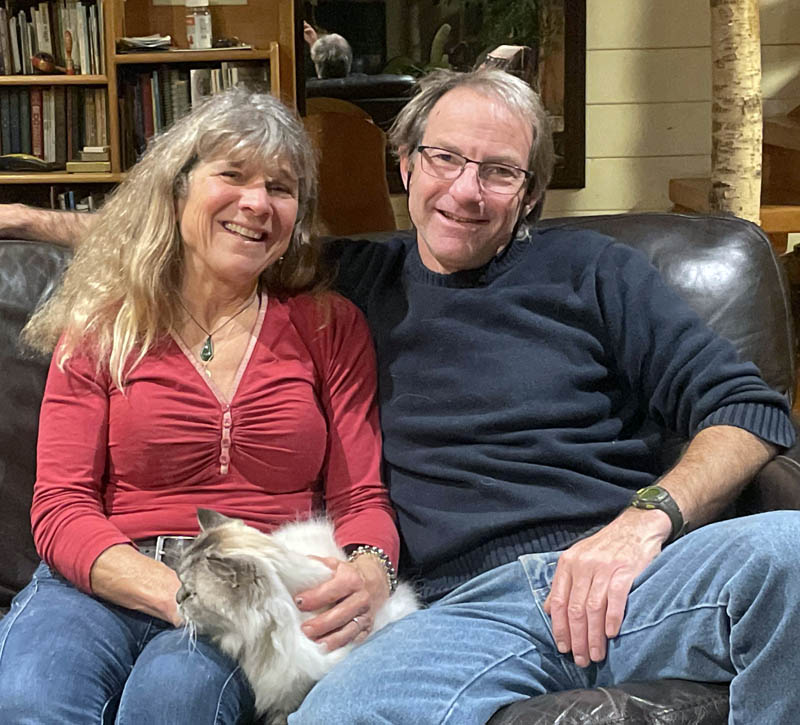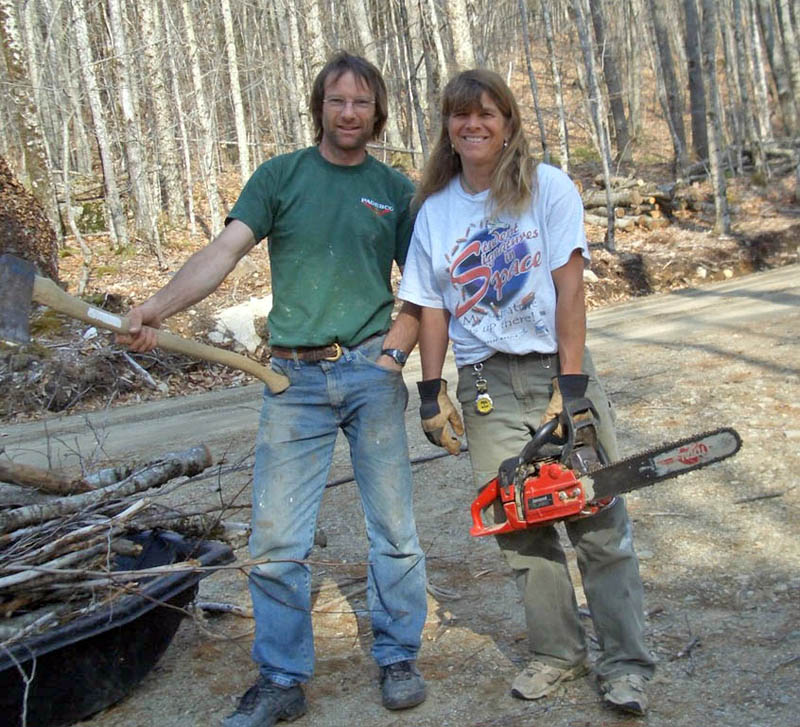
Jaja and Dave Martin relax at their self-built home in Bremen with their pet cat, Shackleton. After sailing the world for almost two decades, the Martin family arrived in Lincoln County in 2003 and found the community they were looking for. (Sherwood Olin photo)
Who hasn’t thought about living the dream? To chuck it all – the job, the bills, the grind – and leave it behind to travel as freely as the wind blows, unencumbered by any concern other than safety and good health?
For the part of the dream that involves sailing around the world, welcoming risk and adventures in equal measure, Dave and Jaja Martin have not only been there and done that, they actually did write a book about it.
Published in 2002, “Into the Light: A Family’s Epic Journey,” chronicled the Martin family’s three-year, 11,000-mile voyage that included stops in the Bahamas, Bermuda, Iceland, the Faroes, Northern Scotland, Norway (including Spitsbergen), Greenland, and Newfoundland. The book later spawned a 2006 documentary, “Ice Blink: A Family Navigating Life’s Ice Clogged Waters,” which aired on PBS in 2008.
By the time the Martins sailed into Round Pond harbor in 2003, Dave Martin had been cruising more or less for 20 years straight, and Jaja for 17. Neither knew it then, but they had arrived in the home they were looking for. By that time the couple’s three children were nearing their teenage years and both parents felt it was time to move forward in a different manner.
“We wanted to cruise,” Jaja Martin said. “That’s what we were doing for us. That was our thing: cruising and circumnavigating and adventuring, but once they were teenagers it was their life and they didn’t choose that and I thought they should be able to choose what they want; whether they want to dance or sing or play sports or whatever. That was the reason why we stopped. It was for the kids, so they could choose what they wanted.”
Much to their delight, the Martins quickly realized the Midcoast community recalled the various Scandinavian towns they lived in during their time cruising the North Atlantic.
“All of the Scandinavian towns had really strong communities, really strong; just people volunteering in the community, in the schools and everything was very close,” Dave Martin said. “We arrived in Maine by boat and everything that we thought about that we want is here. Arts? Arts are huge here. You look at schools across the country, that’s all gone … It just felt good.”
At the time of their arrival, virtually everything the family owned fit onto their 33-foot steel sloop, Driver. The Martins threw themselves into their new home with gusto.
They enrolled the kids in school, first in Bristol Consolidated School and later, Great Salt Bay Community School in Damariscotta where both parents volunteered. Dave Martin found work in local boatyards and Jaja began working at BCS. She currently teaches water aerobics at the Wiscasset Recreation Center and sailing at the CLC YMCA’s summer sailing camps in Round Pond, among other roles. She is also active in local arts organizations like the Seacoast Orchestra, the Tapestry Singers, and the Heartwood Theater Co.
Dave Martin founded his woodworking company, Direction Woodworks, in Bremen in 2018.

The Martin family enjoys the weather outside their completed Bremen home in 2018. Dave Martin calls the design Northwest contemporary Maine cape. From left: Tiega Martin, Dave Martin, Holly Martin, Jaja Martin, and Chris Martin. (Photo courtesy Dave and Jaja Martin)
During their years at sea, the Martins were primarily self-sufficient due to a combination of desire and circumstance. They applied that same determined self-reliance with them when they moved on land.
Buying a 25-acre lot in Bremen in 2003, they built their house themselves, entirely off grid, beginning with the small building that is now their garage that they lived in while they building the main residence, which Dave Martin described as a “Northwest contemporary Maine cape.”
During construction, Dave Martin scoured local job sites for building tips.
“We had a rough idea how the house was going to look so we kind of built to those specs,” Dave Martin said. “I would drive around to these construction sites and I would park and look at the framing and see, oh, that’s how they do it above the windows … If I can see something I can build it.”
“I picked up a lot of skills because when we were cruising, if someone offered you a job, you said ‘yes,’” Dave Martin said. “If you had no idea what to do you got at least one day’s pay out of it and that was huge. You just said yes and figured it out. There was no saying ‘no, I have never done that before.’ No, no, no, no. I’ll take it. I’ll be there.”
During their cruising years, the Martins supplemented whatever income they could make working during shore visits with a steady stream of magazine articles and pictures. Many of those articles were written on a barely functional child’s typewriter.
“That was our Patreon of the day,” Jaja Martin said.
The couple would fax articles to various periodicals when they could, and mail rolls of film and often wouldn’t see what they submitted until months later, if then.
“Magazines paid really well 20, 30 years ago,” Dave Martin said “You could make a good living. Cover shots were $600. A quarter-page picture was $400. Feature magazine articles with photos (were) $1,500. That was the real deal and that’s all gone.”
A craftsman by trade and a sailor by birth, Dave Martin said he found the writing process difficult, but it was a means to an end. The Martins’ unusual story, a growing family cruising the high seas, first in a 25-foot boat and later in a 33-footer, helped distinguish their submissions among others, Dave Martin said.
“We had a story, 25-foot boat, two babies,” Dave Martin said. “It didn’t matter what we sent in – top of the stack, right away.”
Today, the Martins’ middle child, Holly Martin, is currently engaged in her own circumnavigation attempt. When Holly Martin needs to generate income or interest, she creates, edits, and uploads a video to a digital platform. That avenue was not available to Dave and Jaja Martin.

Dave and Jaja Martin have time for a smile while working on their house in Bremen. (Photo courtesy Dave and Jaja Martin)
“She thinks it’s nothing, but she does a pretty good job of it,” Jaja said. “When we were out there we could never make a living that way because it didn’t exist so we had to get jobs on land. A lot of our crazy, weird, bizarre stories we can’t tell even are from these jobs that we had. We met a lot of weird people and we did a lot of weird things in all different countries and it was whole different experience than editing on a computer.”
Modern technology may make it easier to navigate, earn money, and stay in touch, but for all the positives, but the change to the cruising lifestyle has been dramatic, the Martins said. When they started out in 1988, the internet and GPS weren’t invented yet and cellphones were not yet in widespread use.
“It was just a different world,” Dave Martin said. “We left Panama to cross the Pacific and we called home. We said, ‘well we headed off across the Pacific. We’ll be in touch in about three months’ and they were like ‘okay, sounds good.’”
Holly Martin, who is currently in New Zealand, is in touch with her parents virtually every day in one form or another. At home in Bremen, Jaja Martin tracks Holly’s progress and monitors weather reports for her daughter.
“It just killed a whole way of life, the GPS,” Dave Martin said. “Because working out a sextant site with a piece of paper and a pencil and a watch and you do the thing and you go through the tables, and I did it all by hand. I didn’t have any computer program. I just did the math. It was very satisfying. It’s a very ethereal process. You located yourself on the surface of the Earth. Then you transfer it to a chart and you do running fixes. It was pretty cool. Now you look at GPS and you look at the thing and ‘oh, we’re here.’”
“It took the magic away,” Jaja Martin said. “It opened the sport. There was a lot of sagacity that one needed in order to cruise, and self sufficiency. You either attained that or you stopped cruising.”
The Martins’ book and more information are available at iceblinksail.com. Dave Martin’s company, Direction Woodworks, can be found online at directionwoodworks.com.
Holly Martin can be followed via her YouTube page, bit.ly/3XD, or her Patreon page, patreon.com/windhippie.
(Do you have a suggestion for a “Characters of the County” subject? Email info@lcnme.com with the subject line “Characters of the County.”)



